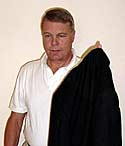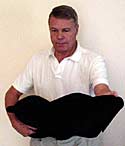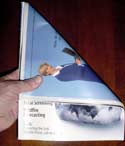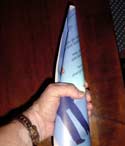Fighting Back At 40,000 Feet:
Part 3 – Weapons, Shields and Artillery
By Christopher Caile
Editor’s Note: Part
1 of this series discussed the possible eventuality of a terrorist
takeover of an airplane, and the dilemmas of choice and morality that
such an event would present to passengers. In Part
2, I examined some of the group strategies and individual tactics
and methods that could be used to fight back. Here, I address weapons,
shields and other items available to you in such emergencies.
|
Defending against
an attack, aided by a suit coat rolled around him forearm
as a shield, this passenger strikes back with a low, bottom
of the foot stomp kick to the attacker’s knee. |
|
Airborne terrorist often depend on weapons. Knives, box cutters and other
bladed or sharp pointed weapons, guns are intimidating. They know this
and use the fear against you. They depend on you feeling helpless and
not knowing what to do. Even worse, they may take hostages and if you
get in their way, watch out. They’re ruthless.
But you aren’t defenseless. You can use everyday items as weapons,
shields or spears: your laptop computer, cell phone, wallet, briefcase
and many other items to create your own arsenal. You simply have to recognize
what can be used and how. These items will not guarantee your success,
but better armed than naked against fanatical armed assailants.
But don’t wait. Think about this topic now, because if you wait
until the last second, until you are faced with actually doing something,
it may be too late -- you may not be able to think clearly, or you may
miss items that could save your life.
Instant Help: Shields
|
Holding a briefcase
in front of you as a shield |
|
If a terrorist with a knife or other bladed weapon was near me and I
had decided to spring into action (from the front), I might look for something
I could use, quickly – some physical object to block or smother
the weapon, or to cover and protect part of my body, such as my arm used
to ward off an attack If the shield is large enough (such as a seat cushion
or carry on bag) it can be used to push or smother an attacker’s
movement, or distract him until, hopefully other passengers intervene.
Shields are everywhere. You can use a large pocket book, brief case,
or carry on bag. One of the best barriers to use is a seat cushion from
an unoccupied seat. Since these seat cushions are often designed to be
used as a floatation device, they come loose easily and conveniently have
handles or straps by which you can hold them. On “water equipped
flights” (those over the ocean), however, life vests and other water
safety items are found under the seats, and the seats themselves are not
easily removable.
 |
 |
 |
You can quickly
improvise a shield to cover your forearm by wrapping a suit coat,
jacket or overcoat around it. Start by grasping the inside of the
collar. |
Extend your
left hand and pull the end of the coat toward you to start wrapping
it around the forearm. A suit coat will normally wrap around the
forearm twice, while a longer overcoat will go around three times. |
Hold your
shielded arm in front of you. Be careful to keep the back of your
arms turned outward so as to protect the more vulnerable inside. |
Shoes can also be pushed over bare hands for protection from knife cuts.
Overcoats, topcoats, jackets, blankets, sweaters or other items can be
wound around your forearm to protect it from knife slashes or hits from
hard objects. And don’t forget to use an injured or subdued terrorists
himself who can be held up as a shield against his friends.
In most airline galleys there are also metal storage boxes affixed to
the wall that have large square metal lids with handles. They can make
excellent shields and might even be able to deflect or slow down a bullet.
Their corners can also be used as weapons.
Barriers
Barriers are used to block movement by an assailant or to deny entry
into an area by others. Most often it is a passenger, sometimes aided
by a shield, who physically blocks an aisle or area with his body. This
person can also use the threat of an improvised weapon, or use hard kicks
(see part 2) to intimidate and forestall movement or attack.
A disarmed, subjugated assailant can also be used as a human barrier
to block movement of his friends. If a serving cart is accessible, however,
it can also be used to help block an aisle or the path of an attacker.
Improvised Weapons (lances, clubs and maces)
Weapons are equally abundant around you. Look for heavy, hard or hard
cornered objects, or things with points or that can be folded to make
a point. These types of weapons have an advantage over you own natural
weapons like your fist – they extend your range of attack. They
can also be more threatening. Below, I have categorized various types
of improvised weapons.
Weapon and Shield Combo: The corner or edge of any hard
object, such as the corner of a computer or a semi-hard briefcase, book,
or the edge of a metal galley container cover. The object can be used
as a shield, but also pushed forward to strike an assailant’s neck
or a corner can be thrust into an eye socket (see illustrations in Part
2).
 |
 |
 |
Turning a
magazine into a spiked weapon is easy. Start with it flat. |
Fold one
corner onward. |
Fold the
entire magazine again in the same direction. |
Spiked Lances: A magazine can be folded to make a hard
point along the ridge of its binding. A pen or pencil can be stuck in
the fold of a wallet, a business card carrying case, soft cover book,
or wrapped in a glove, or the pointed end of a spiked comb can be used
to stab like an ice pick – into the eyes, neck or other soft areas
of the body.
 |
 |
 |
The end of
tightly rolled paperback book is used to strike at an attacker’s
throat. |
The hard
edge of the end of a full soda can is used to strike an attacker’s
temple. |
A pen stuck
into the fold of a business card holder, wallet or paperback book
can be held in the hand and used as a spiked weapon. |
Clubs: Hard objects held in the hand, such as a camera,
cell phone, CD-playier, full can of soda, or a computer transformer. Even
a paperback book can be used if it is rolled up tight in the hand. The
striking surface is the tightly backed rolled end. In the airline bar
cart or galleys there are also usually small bottles of wine that can
be held in the hand, the end protruding, and used as a small club. In
first class, once the flight is in the air there are also usually full
sized bottles of champagne and wine sitting out on the counters of the
first class galley for easy access. These make perfect clubs.
|
Here a briefcase
is swung overhead like a mace into the head of an attacker.
Because of the low ceiling, the arm is brought up first, but
then pulled down as the briefcase swings forward. |
|
Mace-like Swung Items: A briefcase (if it has hard corners)
can be swung at shoulder height (so not to hit the low cabin ceiling)
to target the head (illustrated in Part 2) or neck or swung underneath
and up into the groin. Heavy, hard objects can also be put in a sock,
fanny pack or in a shirt and swung as an impact weapon like a mace used
by European medieval knights (also illustrated in Part 2). Useful objects
include a computer transformer, camera, full can of soda or any other
small weighty object. The cover from an airline pillow can also sometimes
be used to hold the object, but be sure it is cloth, not paper.
Knives, Bladed Weapons and Guns: While these are not
initially available to passengers, if an armed terrorist is subdued, his
or her weapon becomes available.
Projectiles (personal artillery)
Projectiles are any items that can be thrown or projected into the face
or path of an assailant to distract him, make him flinch, or to affect
his eyesight momentarily. Their use provides a split second opportunity
for other action.
Use pocket change (illustrated in Part 2) or other pocket items as keys.
Don’t forget that any liquid in a cup, such as coffee, juice, soft
drink or liquor, works well too. This includes spitting into someone’s
face. You can also use about anything else you can pick up including a
camera, full soda bottles, etc., but be careful not to hit other passengers.
Thus these objects are best used before actual engagement, when you as
an individual or a group of people are closing in.
Use of these items also presents a danger. They might be thrown back.
More importantly, however, if the plane should suddenly lose height or
shift position, loose items can become airborne missals that can hit and
injure anyone in their path.
Smothering Items
These are items that can be thrown over the heads of attackers to blind
their visions momentarily and confuse them and/or smother arm movement.
Use of such objects usually include an effort to pin an assailant’s
arm, tackle or otherwise restrain. Use overcoats, jackets, blankets or
other large cloth objects. These have to be used at close range, however,
and the height of the cabin often restricts movement.
Restraining Items
If you are able to overwhelm terrorists, follow-up restraint is necessary.
A group of passengers can pile on a terrorist to neutralize him and hold
him or her in place, but using some form of other restraint is preferable,
especially if it is for a prolonged period of time. Some useful items
for tying up an attacker include: belts, long shoe laces, headset cords
(those provided by the airline and those from passenger CD-players and
other electronic devices), and electric cords or telephone line cords
from computers. Also look for lifelines, which are located over the wing
exit doors. They are used to help passengers navigate across wings in
the case of emergency exit, and are long and somewhat cumbersome. Additional
restraint can also come from a seat belt that can help hold an assailant
in a seat if he or she has been otherwise subdued or restrained.
While the above items do not comprise a full list, they should get you
thinking. They just might help you, or even save your life, if you are
ever confronted by the unlikely event of an onboard terrorist attempt
to take over your airplane.
Disclaimer:
This article is for educational purposes only and does
not represent advice, suggested action or activities that airline passengers
should or could take. It represents the views of the author only, who
is trained in self-defense and the use of weapons. The intent of this
article is only to provoke thought. In the event of an actual airline
incident the direction of airline flight crew, pilots and/or air marshals
should be followed.
About the Author:
Christopher Caile is the Founder and Editor-In-Chief of FightingArts.com.
He has been a student of the martial arts for over 43 years. He first
started in judo. Then he added karate as a student of Phil Koeppel in
1959. Caile introduced karate to Finland in 1960 and then hitch-hiked
eastward. In Japan (1961) he studied under Mas Oyama and later in the
US became a Kyokushinkai Branch Chief. In 1976 he followed Kaicho Tadashi
Nakamura when he formed Seido karate and is now a 6th degree black belt
in that organization's honbu dojo. Other experience includes judo, aikido,
diato-, kenjutsu, kobudo, Shinto Muso-ryu jodo, boxing and several Chinese
fighting arts including Praying mantis, Pak Mei (White Eyebrow) and shuai
chiao. He is also a student of Zen. A long-term student of one branch
of Traditional Chinese Medicine, Qigong, he is a personal disciple of
the qi gong master and teacher of acupuncture Dr. Zaiwen Shen (M.D., Ph.D.)
and is Vice-President of the DS International Chi Medicine Association.
He is also a student of Tai Chi under Dr. Shen whose father and teacher
trained in China under the Yang family. He holds an M.A. in International
Relations from American University in Washington D.C. and has traveled
extensively through South and Southeast Asia. He has frequently returned
to Japan and Okinawa to continue his studies in the martial arts, their
history and tradition. In his professional life he has been a businessman,
newspaper journalist, inventor and entrepreneur. |